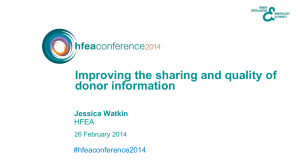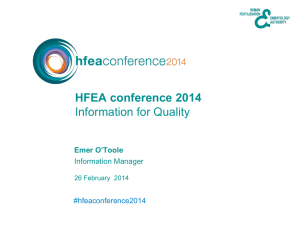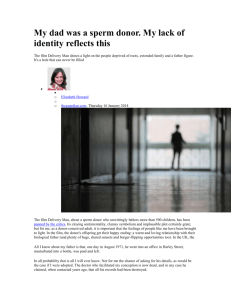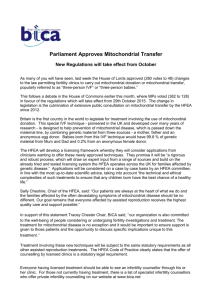Here - Donor Conception Network
advertisement
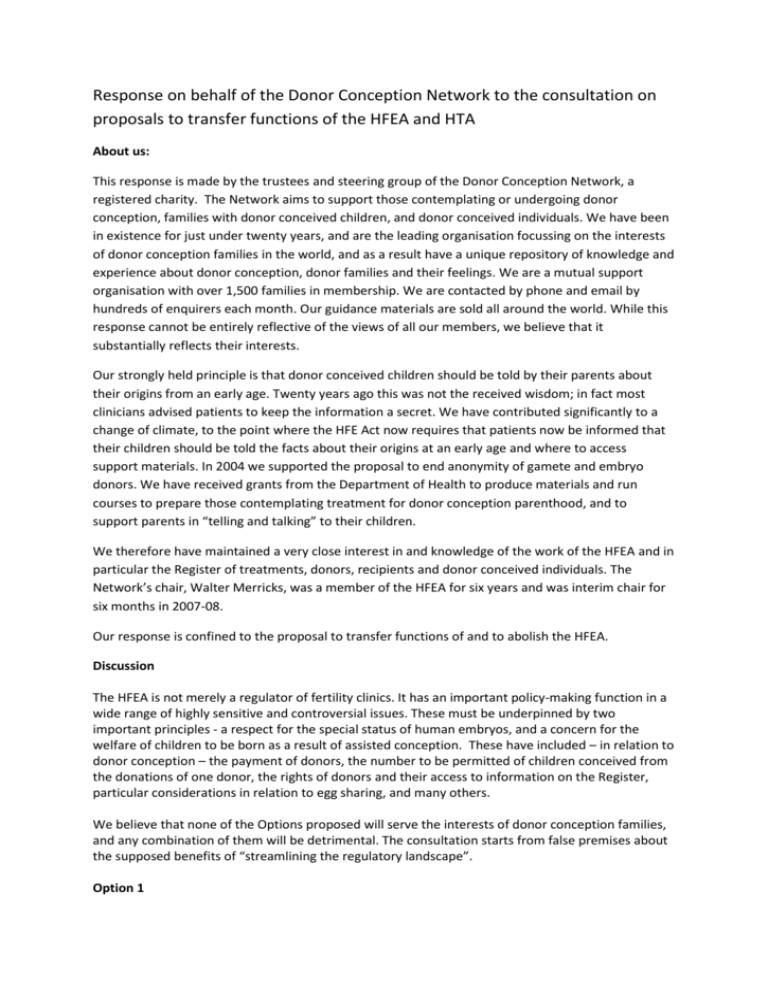
Response on behalf of the Donor Conception Network to the consultation on proposals to transfer functions of the HFEA and HTA About us: This response is made by the trustees and steering group of the Donor Conception Network, a registered charity. The Network aims to support those contemplating or undergoing donor conception, families with donor conceived children, and donor conceived individuals. We have been in existence for just under twenty years, and are the leading organisation focussing on the interests of donor conception families in the world, and as a result have a unique repository of knowledge and experience about donor conception, donor families and their feelings. We are a mutual support organisation with over 1,500 families in membership. We are contacted by phone and email by hundreds of enquirers each month. Our guidance materials are sold all around the world. While this response cannot be entirely reflective of the views of all our members, we believe that it substantially reflects their interests. Our strongly held principle is that donor conceived children should be told by their parents about their origins from an early age. Twenty years ago this was not the received wisdom; in fact most clinicians advised patients to keep the information a secret. We have contributed significantly to a change of climate, to the point where the HFE Act now requires that patients now be informed that their children should be told the facts about their origins at an early age and where to access support materials. In 2004 we supported the proposal to end anonymity of gamete and embryo donors. We have received grants from the Department of Health to produce materials and run courses to prepare those contemplating treatment for donor conception parenthood, and to support parents in “telling and talking” to their children. We therefore have maintained a very close interest in and knowledge of the work of the HFEA and in particular the Register of treatments, donors, recipients and donor conceived individuals. The Network’s chair, Walter Merricks, was a member of the HFEA for six years and was interim chair for six months in 2007-08. Our response is confined to the proposal to transfer functions of and to abolish the HFEA. Discussion The HFEA is not merely a regulator of fertility clinics. It has an important policy-making function in a wide range of highly sensitive and controversial issues. These must be underpinned by two important principles - a respect for the special status of human embryos, and a concern for the welfare of children to be born as a result of assisted conception. These have included – in relation to donor conception – the payment of donors, the number to be permitted of children conceived from the donations of one donor, the rights of donors and their access to information on the Register, particular considerations in relation to egg sharing, and many others. We believe that none of the Options proposed will serve the interests of donor conception families, and any combination of them will be detrimental. The consultation starts from false premises about the supposed benefits of “streamlining the regulatory landscape”. Option 1 It is abundantly clear that the CQC does not wish to take on the responsibilities of the HFEA and the HTA, and it must be doubtful whether it would have the capacity to do so. It cannot be wise to force a public body to take on extra responsibilities for which it believes it is ill-equipped and cannot carry out effectively. This would not only threaten the carrying out of HFEA responsibilities, but also the existing functions of the CQC itself, a body that has already been shown to suffer from serious inadequacies in its performance. The consultation paper ignores the disruptive effect of institutional change on people, processes, systems and services. It assumes that savings can be made while the level of service and performance can remain untouched; there is abundant evidence to the contrary – not least in the formation and performance of the CQC itself. The CQC has a huge range of responsibilities, among which the special needs of the assisted conception and donor conception sectors would be in danger of being lost to view by its board and senior management. These sectors would become insignificant pin-pricks on its risk-map. The interests and concerns of donor conception families would rarely rate a mention on a CQC board agenda. Former HFEA functions would be delegated to the a low level in the organisation. The managers given responsibility for these areas would have less of a focus on stake-holder interests than in attempting to manoeuvre their way through the bureaucratic hierarchy of the organisation. External voices and input would count for less for a large multi-focus regulator than for an organisation whose objectives are more narrowly targeted. The current HFEA staff with their accumulated expertise would find themselves significantly outnumbered; their focus might inevitably be on how to survive in a new climate. The sense of corporate memory and institutional pride in the HFEA’s values and objectives could be lost. The commitment to serving families and individuals will be diminished. Option 2 This option explores two possible functions of interest to us that might not be transferred to CQC if the main proposal in Option 1 was adopted. The first is concerns responsibility for the HFEA Register of treatments, donors, recipients and births. This is of vital interest to donor conception families. The CQC has no experience of or capacity for running such an important register that has to be maintained in existence almost certainly in perpetuity. So the consultation paper suggests that this responsibility might be severed and given to the NHS Information Centre. The HFEA has described some aspects of its work in this area: In a nutshell, it is through its powers of inspection and licensing, which includes audits and management reviews, that the HFEA is in a position to be reasonably certain that the data it collects is complete and correct. Splitting off the hosting of the Register from the wider compliance functions poses a real risk that clinics won’t comply with the extensive statutory reporting requirements and that this will undermine, for example, the information access guarantee that is given to those people conceived from donor treatments. In practice, we often have to go back to clinics when we receive a request for information from a donor conceived person, their parent or the donor themselves in order to clarify issues with the data. We are also routinely engaged in data assurance processes, particularly focused on issues around donation. We feel a major factor in achieving compliance from (parts of) the sector with this is that we are also the licensing body. When a request for information about the outcomes of donor treatments is received (Opening the Register - OTR), a dedicated team at the HFEA interrogate the Register data base, cross checking and referencing a woman’s registration and treatment outcomes, and a donor’s registration and use. [....], this can also involve communications with the applicant and the clinic. External organisations would not currently be allowed to see these Register entries, since this form of disclosure is not envisaged in the current legislation. Furthermore, considerable technical expertise in the Register team is required to analyse the relevant reports from the database that contains data for 20 years of treatments, during which time various form changes regarding the amount and format of information on donors were introduced. Frequently, staff dealing with OTRs also contact centres regarding historic patient data, sometimes from centres which have now closed. HFEA staff handling these requests have had at least basic training in counselling and handling difficult conversations. This does not mean that the HFEA does not recognise that at least some of the people asking for information would like access to further support or counselling services. The need to consider whether counselling would be helpful is flagged up in our correspondence with those requesting information. But we are aware that there is no direct and dedicated support we can signpost people to. In order to address this issue, we held a meeting with sector representatives in 2009. Here it was agreed that the British Association for Counselling and Psychotherapy would, together with representatives of the fertility sector, address the need to increase expertise and knowledge of the relevant issues for interested counsellors. To our knowledge, this has not happened. We are keen to find ways of signposting donor conceived people and other OTR applicants to more accessible and relevant sources of support. We feel that accessing the actual information contained in the HFEA Register is intrinsically linked to our expertise in how the Register was built, how forms have changed over the years and how rules and processes have to be adapted to make sure that as accurate as possible information is given to people who want to understand better their genetic family ties. [Letter to BMA] We oppose the transfer to the HFEA’s functions to the CQC which we think would be little short of disastrous. However the consultation also canvasses another possibility that might be even worse. That would involve splitting the functions and severing responsibility for the compiling, maintaining and manipulating the information on the Register and entrusting this to yet another body unfamiliar with the work and separate from the regulator. It is therefore extremely worrying that the handling of requests might be transferred to a body (NHSIC) that would not have regulatory and licensing oversight of the body from which the data had originally been obtained when as appears to be the case, the source data frequently needs to be checked with the clinic concerned. While some of the requests relate to relatively recent events/data entries, (e.g. from a recent parent: how many other children have been conceived from the same donor’s sperm) many and probably an increasing number will relate to conceptions in the 1990’s when record-keeping and data transfer by clinics was far less accurate than it is today. Because of the poor state of that data, in the early 2000’s it was necessary for the HFEA to carry out a historic audit of birth data going back to 1991. Even after that lengthy and expensive exercise, it was clear that many deficiencies in the data remained. As the HFEA point out, the way that information was recorded has changed over the years, and a consistent team with a good corporate memory familiar, with the history of the Register both from a technological and a regulatory point of view is vital to the effective carrying out of this function. NHS-IC would not have the authority to obtain cooperation in seeking answers to such requests, while failure or delay in responding might suggest that the clinic merited regulatory attention; a quick word with a regulatory colleague might easily resolve such an issue, while a formal reference to a separate regulator might be seen as cumbersome and time-consuming. An opportunity for joined-up good regulation would be lost. Option 2 also canvasses the possibility of severing the responsibility for disclosing information from the Register and transferring that to the Health Department, with possible onward transmission to an external agency. A special HFEA unit that handles enquiries and requests for information from donor parents, donors or donor conceived individuals. As the number of adult (post 1991) donor conceived individuals grows, the volume of enquiries and requests is very likely to increase. Whilst our objection to the transfer of HFEA functions and indeed to their splitting up remains, the balance of advantage here could be altered by another factor not canvassed or even mentioned in the consultation paper. That relates to the voluntary register of pre-1991 donors, recipients and donor conceived individuals, currently run by UK Donor Link. There has always been a strong case that these two registers should be brought together and the disclosure of information from both should be handled by a specially trained team with expertise in counselling, intermediation and family welfare. Since the fate of the UK Donor Link voluntary register is under separate consideration it is difficult to comment further. Conclusion Our concern is that any fragmenting of the services will be detrimental to the quality of service: if the Register is separated, all the other services will lose the contact with the end-users and any new evidence that becomes apparent, if the Ethics section is separated (or ditched altogether, as some have suggested) the lessons being learned in one section will take longer to percolate to the other branches, to the detriment of consistency and effective regulation; if the research and the treatment regulating functions are separated, it more is likely to lead to inconsistency and incoherence. While we have from time to time had cause to criticise the HFEA, we believe that the interests of donor conception families would be best served by retaining its functions in one place, under a specialist board. The consultation paper makes no proposals as to how the balance of lay, ethical and clinical input and expertise to be found on the HFEA board would be replicated in a CQC context. Our serious and strong objection to the break-up of the HFEA’s functions is the risk that the interests of donor conception will be lost amid the huge range of CQC’s responsibilities; that information that should be compiled on the Register will be less accurate as a result of the downgrading and lack of senior management focus; that those requesting information from the Register might be given inaccurate information, or less information than they would or could be entitled to; and that the disclosure of information would be handled poorly. Responses to questions 1. Do you agree with the option to transfer all HFEA and HTA functions to CQC with the exception of HFEA functions relating to research that will transfer to the HRA and abolish the HFEA and HTA? Please explain why you think this. No. We believe that it will be highly detrimental to donor conceived people, to donor conception patients and to donor conception families to lose the specialist expertise of an authority that is familiar with the issues surrounding this subject. 2. Can you quantify what impact this could have at a local level (either in relation to service providers or patients or both)? If the HFEA is retained there will be no impact at local level. 3. Do you agree that HFEA functions relating to research should be transferred to the HRA? Please explain why you think this. No. This would be detrimental to the coherence of the HFEA’s focus on the ethical issues relating to the use in both treatment and research of embryos. 4. Do you think that some HFEA and HTA functions might sit better with bodies other than CQC and the HRA? If so, which functions and which organisations and what do you see as the advantages of the alternative organisation? Not applicable since we believe that the HFEA should be retained. 5. Do you believe the HFEA and HTA should retain existing functions but deliver further efficiencies? Please explain why you think this. We believe that the HFEA should be retained with its existing functions. There is no reason to believe that the HFEA is not already efficient. It has already made substantial savings in its budget. 6. Do you think that retaining functions with the HFEA and HTA could deliver savings to the public purse? If so, please explain how and quantify Not necessarily. This should not be the sole purpose of the exercise. Since the vast majority of treatments are paid for directly by patients, the impact on the NHS of the HFEA is minimal. 7. Within the option of retaining the HFEA and the HTA as independent regulators, are there any of their functions you think should be transferred elsewhere and, if so, which and why? No. 8. Do you have any comments on our assessment of the efficiencies associated with the different options in paragraphs 154-158 above and in the accompanying consultation Impact Assessment? The impact assessment fails to assess the impact of the removal of senior managers on the quality of service, and naively assumes there would be no detrimental impact. There has been no assessment of the impact on bodies such as ourselves, should the HFEA’s functions be split or transferred to the CQC. If either of these happened we would have to spend time engaging with a new set of organisations, helping them to understand the needs of our community. The time and energy would represent a cost to a small charity such as ourselves. 9. This consultation focuses specifically on where functions might sit and implementation will be at the discretion of the regulators. However, if you have any views as to how functions might be undertaken in future or other issues of concern that we could share with the bodies undertaking these functions as they plan for the future, please let us know. We will engage with such bodies as are entrusted with the functions with which we are concerned when decisions have been made. 10. Do you have any other comments on the consultation proposals that you would like to share with us? The consultation starts from a premise – that current functions are mis-allocated and that savings can be made without detriment to service to users – for which no evidence is produced. 11. Can you provide examples of costs and benefits of these proposals? As mentioned above, there would potentially be transitional costs for all those external organisations engaging with new and unfamiliar bodies. There are no benefits. 12. Do you have any comments on the consultation Equality Analysis? No.
